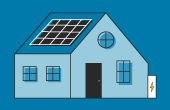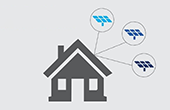Easy to use and nearly maintenance free, this system provides security, value, and sustainability to my life
$480
100%
or more of electricity
$19,000
2.5%
Property
- Owner:
- Andrew Sirois
- Type:
- Single-Family Residence
- Address:
- 314 e 19th st, Cheyenne, WY 82001
- Size:
- 1,450 sq ft
- Energy need met:
- 100% or more of electricity
- Designations:
- Zero net energy
Technology
- Type:
- Solar PV
- Installed:
- May 2019
- Size of System:
- 5.7 kW
- Monitor performance:
- https://www.apsystemsema.com/ema/intodemouser.action?id=0b28481b6d423044016d476b8e71158d&locale=en_us
- Purposes:
- To generate electricity
Financial Details
- Gross Cost of System:
- $26,000
- Value of Tax Credits:
- $7,000
- Net Cost of System:
- $19,000
- Annual Savings:
- $480
- Own or Lease:
- Purchase with Loan
- Additional Financial Notes:
- Wyoming does not currently require utilities to buy power, but will eventually. You can get a loan with an APR much lower than your mortgage. Switching to an electric water heater will save us an additional $25/mo. in gas.
Professionals & Suppliers
- Products:
- Peimar Group
- Installers:
- Sopris Solar
- Financing:
- loan pal
- Builders:
- Lone Star Construction, LLC
What You Need to Know
Description:
15 300w panels @ 19% efficiency fit on the sunny roof and 4 had to go to the back due to a restrictive local code pushing in 3ft from edges. The move resulted in 50% loss on those panels. Actual panel performance is 280w (the advertised number is the test performance) for a total of 5.3kW. We get 233 days of sun here.
Other Benefits:
The panels are supposed to protect the roof from hail, which it has done admirably so far. We get a lot of hail. It looks badass.
Maintenance Requirements:
None.
Efficiency or Sustainability Improvements:
We heat with a wood stove in the winter so our gas usage is almost nothing. Insulative drapes over all windows (which are double pane). Most of our sustainability comes from line-drying clothes, reusing some gray water, growing only local grasses and flowers while planting very little else to reduce water use. 150 gallon rain catchment system.
My Motivation:
Walking the walk
Advice:
Get high quality panels to avoid maintenance costs and minimize roof space needed. You only want to install once. Calculate your energy needs with future electric appliance conversions or purchases in mind (such as a/c units, water heaters, etc). Use the actual (not test) performance metrics of the panels you're considering to approximate the amount you need, then figure out how much space they will need on the roof considering local code requirements.
Experience with Installer:
Make sure you insist on a lien waiver from your installer in case they turn out to be crooks (this actually happened to me). This is standard practice in the industry and your installer will provide this in order to keep your business. The actual installers may be subcontractors and you have to deal with them as such. Permitting and inspecting can be a hassle if the county and the utility aren't on the same page.
Additional Notes:
The tax credit is being reduced to 22% over the coming years to hop to it. Battery tech is taking off at a powerful rate due to e-cars. Now is a good time to also get batteries so that you can actually own and use your own power. On the other hand, waiting a few years will save you a lot of money. The utility may not buy excess power you produce so plan to maximize electricity use and minimize other utilities if possible.
View Other Case Studies
Search for Other Case StudiesThe EnergySage Marketplace





